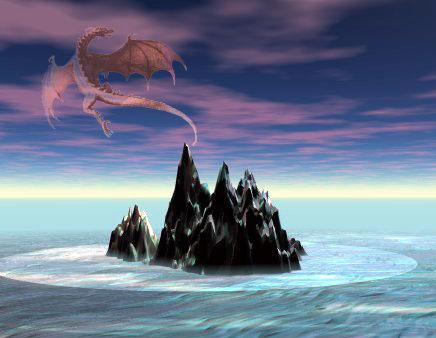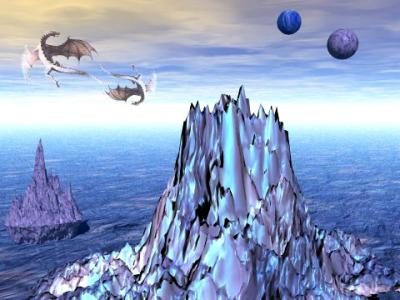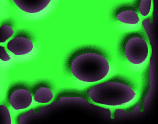|

The History of Dragons
Dragons are an ancient , winged reptilian race. They are known and feared for the prowess and magical abilities. The oldest dragons are among the most powerful creatures in the world. Most dragons are identified by the color of their scales.
There are many known subspecies of dragons, several of which fall into three broad categories: chromatic, gem, and metallic dragons. Chromatic dragons include black, blue, green, red, and white dragons; all are extremely evil and are feared by most. The metallic dragons are the brass, bronze, copper, gold and silver dragons; these are noble and good, highly respected by wise people.
The gem dragons are the amethyst, crystal, emerald, sapphire, and topaz dragons, they are neutral with respect to good and evil, and are very charismatic and suave, masters of persuation who delight in riddles.
Though generally smaller and slower than other dragons, gem dragons are often wiser and more intelligent, and have other powers to compensate, like psionics.
In addition to the dragons in these three classifications, there are other dragons that my at first seem to be members of those categories. For instance, the steel dragon seems to be a metallic dragon, but has only on breath weapon; while each "true" metallic dragon has two. Likewise, the brown dragon seems to be a typical, evil chromatic dragon; but has no wings, so is not a "true" chromatic dragon.
Although all subspecies of dragons are believed to have come from the same roots tens of thousands of years ago, the present subspecies keep to themselves, working together only under extreme circumstances, such as a powerful mutual threat. Good dragons never work with evil dragons, however, though a few neutral dragon specimens have been known to associate with evil or good dragons. Gold dragons occasionally associate freely with silver dragons, and emerald ones are sometimes found with sapphire dragons.
When evil dragons of different species encounter each other, they usually fight to protect their territories. While good dragons of different subspecies are more tolerant of each other, they are also very territorial. They usually try to work out differences in a peaceful manner. Gem dragons often settle inter-species disputes with riddling contests.
All subspecies of dragons have 12 age categories, and gain more abilities and greater power as they age. Dragons range in size from several feet upon hatching to more than 100 feet, after they have attained the status of great wyrm. The exact size varies according to age and subspecies. A dragon's wingspan is about equal to its body length; 15-20% of a dragon's body length is neck.
Generally, when multiple dragons are encountered they are a mated pair and young. Mated dragons are always young adults, adults, or mature adults; young dragons found with their parents are of the young adult stage or younger.
During the early part of a dragon's adult stage it leaves its parents, greed driving it on to start a lair of its own. Sometimes, although rarely, juvenile dragons leave their parents to start their own lives. As a pair of mated dragons age beyond the mature adult stage, they split up, independence and the lust for treasure driving them apart. Oder dragons of either sex sometimes raise young, but only on their own - the other parent leaves when the eggs are laid.
Dragons, especially older ones, are generally solitary due to necessity and preference. The distance themselves from civilization, which they consider to be a petty and foolish mortal invention.
Dragons are fearsome predators, but scavenge when necessary and can eat almost anything if they are hungry enough. A dragon's metabolism operates like a highly efficient furnace, making use of 95% of all the food the dragon eats. A dragon can also metabolize inorganic material, and some dragons have developed a taste for such fare.
Although dragons' goals and ideals vary among subspecies, all dragons are covetous. They like to hoard wealth, collecting mounds of coins and gathering as many gems, jewels, and magical items as possible. They find treasure pleasing to look at, and they bask in the radiance of the magical items. For a dragon, there is never enough treasure. Those with large hoards are loath to leave them for long, venturing out of their lairs only to patrol the immediate areas or to get food. Dragons like to make beds of their treasure, shaping nooks and mounds to fit their bodies. By the time they mature to the great wyrm stage, hundreds of gems and coins are imbedded in their hides.
 |

